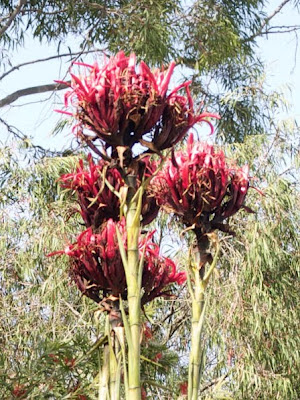We passed through Bakers Swamp without noticing anything. Then reached our last dot on the map for this trip - Larras Lee and saw this. The roadside monument says: In Memory of WILLIAM LEE (1794 - 1870) of "Larras Lake" a pioneer of the sheep and cattle industry and first member for Roxburgh under responsible government (1856 - 1859). This stone was erected by his descendants. --- 1938 --- This is a repost from a few days ago. Thinking I would use this for this week’s Taphophile Tragics post I dug a little further into William Lee’s story, it’s a very colonial Australian one. William was born of convict parents, living his childhood years around the Sydney region. In his early 20s he was issued with some government cattle, recommended as a suitable settler and granted 134 acres at Kelso near Bathurst. He was one of the first in the area and did well. A few years later he was granted a ram and an inc...


Aha .. these look so strange to my eyes -- almost spooky .... reminding me ... wait for a second ...triffids!
ReplyDeleteI've heard of gymea lilies before, but I've never seen one.
ReplyDeleteThese are spectacular.
I wonder if they would grow here,
These are so amazing! I'm sure I've never seen them.
ReplyDeleteYou have captured them so well. What a spectacular clump!
ReplyDeleteI have tried to photograph them as they litter my campus, but never as well as this.
They are a little triffid-like...
Lettie, I just checked the web. They apparently grow well in coastal areas and will grow inland but don't like frost so need to be protected from it. We don't see them up here in the mountains.
ReplyDeleteJulie, I think this clump was well placed for a reasonable shot. I particularly liked the way the red bottle brushes complemented the tall flower but that didn't really show up the photo.
You may not have many menhirs at the other end of the world, but you do have some fascinating flora and fauna
ReplyDeleteI have asked so many people what Gymea lilies are, the most "authoritative" (i.e. from answer from one of those people who are very definite in their view) was imports from South Africa. Thank you for this information (I love them by the way - and I did think they looked very Australian
ReplyDelete